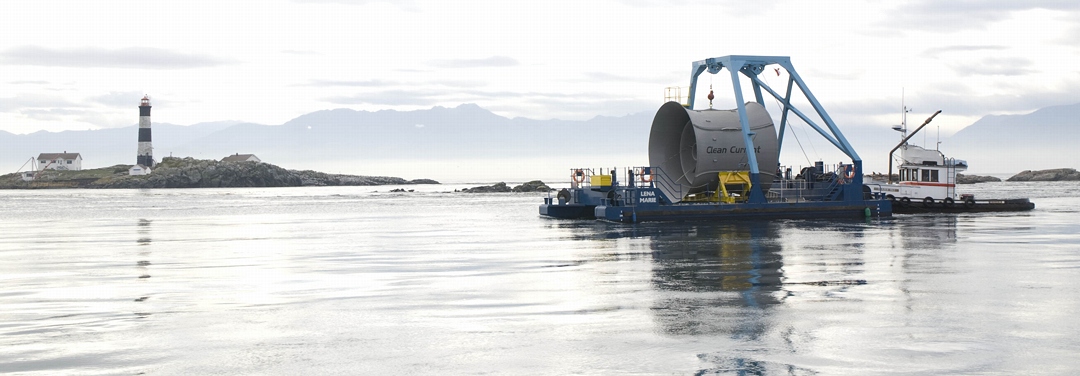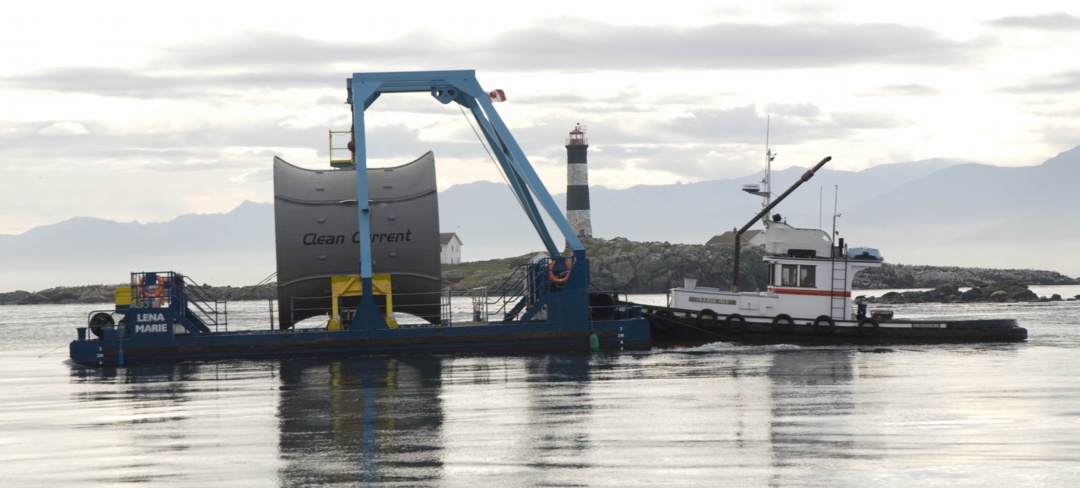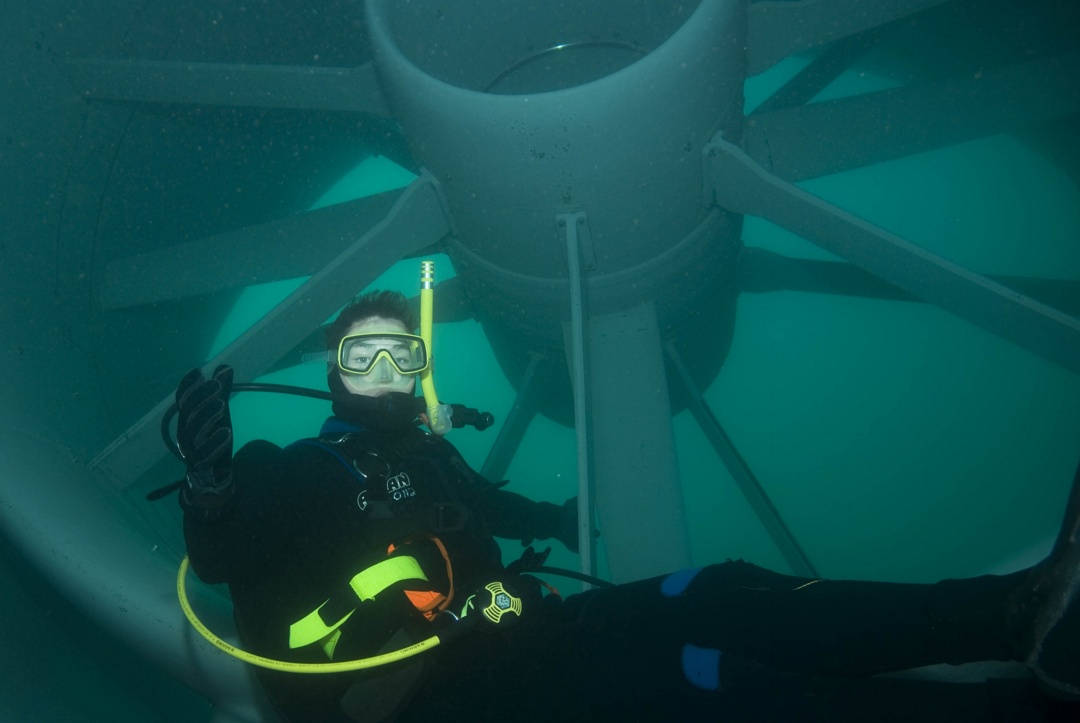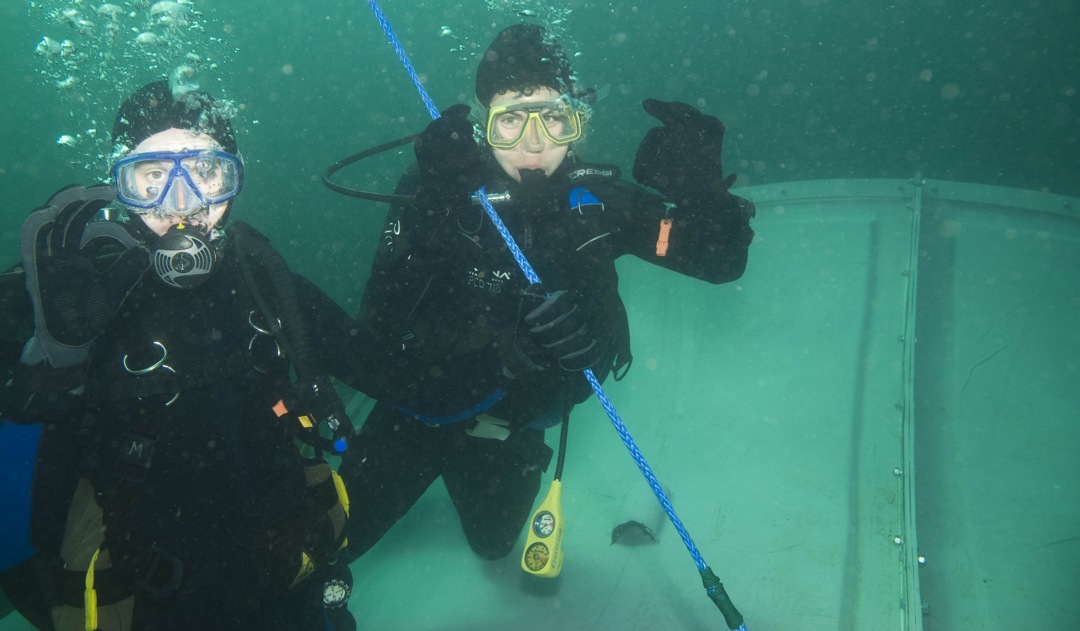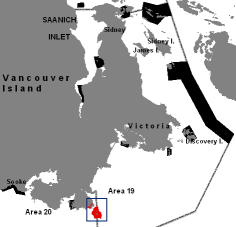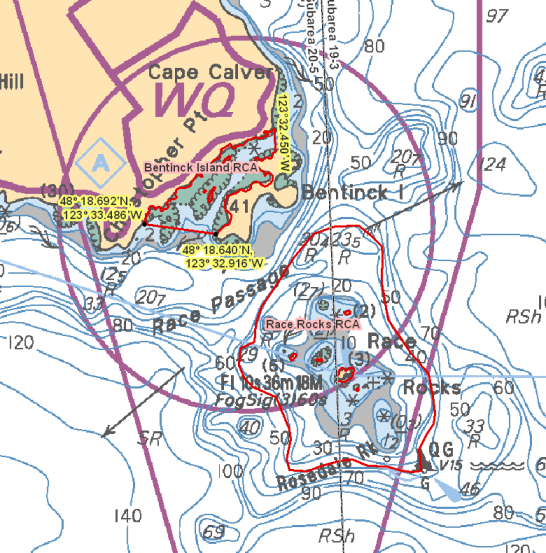The baby elephant seal is present outside the concrete pad again today. Its back is covered in small wounds and every move it takes seems to be an effort. It spent all day sleeping beside the jetty. Wondering if it is sick or in poor health..The number of sea lions (both stellar and California) is growing daily. Most are hauled out on the NE corner of Gr. Race and on Middle Rock. Some are also on the southern rocks as well. A flock of four Canada Geese was present on the island for a few hours this morning. Seagull chicks are still growing, with many spreading their wings and starting to lift off from the ground. Carcasses in various stages of decomposition have been found scattered across the island this week, with two new ones beside the cistern spotted yesterday. Slash has not been seen for a week now. A number of infractions from recreational boats occurred today, including viewing animals from less than 100 metres, fishing and traveling at speeds greater than 7 kts. Recreational boaters are reminded that violation of the Marine Mammal Regulations (rev. 2006) may constitute a fine up to $100 000. Adam, 21:25:22
Category Archives: Admin
Visitors to Race Rocks
Glen Rasmussen, of the DFO Nanaimo office and a group of his counterparts from New Zealand made a trip with Garry and Chris to Race Rocks.
Race Rocks Update May 2009
Eight Years Later: It is with irony that I write this update, 8 years to the day since Angus Matthews wrote an update in 2002
In 2001 we were still optimistic that a full fledged MPA for Race Rocks would be forthcoming. In the interim, most of the members of the Race Rocks Advisory Board have moved on. As for the representatives of Lester Pearson College, Angus Matthews is now Executive Director of the New Marine Centre in Sidney, and Garry Fletcher has retired from teaching at Pearson College, but remains as Educational director of the racerocks.com website and assists with advice in the administration of the reserve. Chris Blondeau, the Director of Operations of Lester Pearson College is now in charge of administering Race Rocks for the College.
In the interim, Lester Pearson College has continued to raise funds to provide an Eco-guardian at Race Rocks since the de staffing of the Lightstation in 1997. Mike and Carol Slater retired in 2008. and Ryan Murphy, a former student of Lester Pearson College and now a graduate student from Memorial University is now hired as our resident Eco- Guardian. Over $1,000,000 has been raised by Lester Pearson College dedicated to the protection of the reserve since 1997. BC Parks has been helpful in providing for infrastructure upkeep on the island . DFO has not contributed anything to the operation of the reserve.
The rejection by the First Nations of the Gazetted version of the Advisory Board proposal of 2001 led to a cessation of the advisory process . A significant change in the text of the original proposal of the Advisory Group when it was submitted to DFO made the proposal unacceptable to First Nations as well as to many others of the Advisory board.
Sean LeRoy et al, have analyzed the process and have documented it in the Publication : Public Process and the Creation of the Race Rocks Marine Protected Area
From page 8:
” On October 28, 2000, the draft regulations for the XwaYeN (Race Rocks) Marine Protected Area appeared in the Canada Gazette, Part I (O’Sullivan 2000). The proposed regulatory text established the no-take zone within the boundaries of the Ecological Reserve. The accompanying Regulatory Impact Analysis Statement (RIAS) incorporated most of the other consensus recommendations of the RRAB, but also stated: “…although the creation of the MPA does not restrict harvesting by First Nations for food, social or ceremonial purposes, they volunteered to forego this activity in support of the designation of the MPA”
This provision was a surprise to the CSSC, other members of the RRAB, and many at DFO. In November 2000, the Chiefs of several Douglas Treaty First Nations wrote a letter of objection to the Minister of Fisheries and Oceans, citing the Delgamuukw vs. British Columbia (1997) decision, infringement of treaty rights, and lack of consultation (RRAB 2001). It is not clear whether this objection was a direct result of the Gazette publication, or whether it derived from earlier events such as Miramichi Bay or the ‘designation’ ceremony. Regardless, the regulatory process was halted immediately. Caught in the crossfire, the CSSC lost any currency it had as an intermediary between the Douglas Treaty First Nations and DFO, and has not been involved in the deliberations ever since.
In December 2000, DFO met individually with each Chief of the Douglas Treaty First Nations, acknowledging that proper consultation had not taken place (RRAB 2001). By June 2001, the Chiefs had written a letter of support for the MPA, on the condition that there was true co-operation and acknowledgement of Douglas Treaty rights. Negotiations to allow the final designation of the MPA are currently ongoing (April 2003). “
During the interim since 2001, DFO has pursued negotiations with the local First Nations Treaty Group. In April of 2009, DFO representatives have expressed interest in resolving the issues this year.
So now from my viewpoint in 2009, the perspectives on the MPA process have changed somewhat. We are currently committed to maintaining the ecological sustainability of the provincially designated Ecological Reserve. The Ecological Reserve has now been in operation for 29 years. The community has accepted the importance of the area and has recognized the value of conservation. It would be of great assistance to Lester Pearson College if the area was to become financially sustainable with support from governments. I am not so sure however if the designation of MPA status remains of any value.
On the DFO webpage http://www.pac.dfo-mpo.gc.ca/oceans/mpa/fntreaty_e.htm the following is a statement on
Respecting First Nations and Treaty Process :
“Canada and B.C. consider First Nations support and participation in the MPA Strategy as important and necessary. Both governments will ensure and respect the continued use of MPAs by First Nations for food, social and ceremonial purposes and other traditional practices subject to conservation requirements. Therefore, MPAs will not automatically preclude access or activities critical to the livelihood or culture of First Nations. The establishment of any MPA will not preclude options for settlement of treaties, and will address opportunities for First Nations to benefit from MPAs.”
Given the above statement it is hard to imagine why 9 years has passed without this being resolved and why no support in the interim has been forthcoming from DFO for the Ecological Reserve. It would appear that it is successful as it is now so one might wonder why adding another layer of bureaucracy is necessary.
The above statement represents the personal opinion of Garry Fletcher.
The story of Ninene: Seal pup likely Canadian-born; now she’s missing
This story is reproduced courtesy of the Penninsula Daily News: penninsuladailynews.com
By Rob Ollikainen
Peninsula Daily News
PORT ANGELES — A young elephant seal pup that beached itself on Hollywood Beach last weekend is more than likely a Canadian named Ninene.
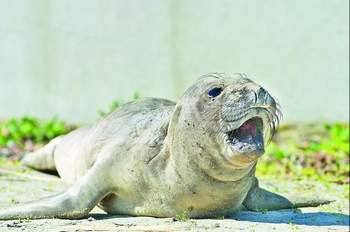
A molting female elephant seal lies on the sand at Hollywood Beach in Port Angeles on Monday. Police taped off the area around the seal to keep people from approaching the animal. — Photo by Chris Tucker/Peninsula Daily News
Scientists believe the elephant seal pup that washed up near City Pier is the same seal born Jan. 30 at Race Rocks Marine Ecological Reserve. That seal was named Ninene by researchers at the British Columbia reserve.
The malnourished, scarred female seal was taken from Hollywood Beach — where Olympic Coast National Marine Sanctuary had protected her from onlookers by erecting yellow tape around her on Sunday — to the end of Ediz Hook near the Coast Guard Group/Air Station Port Angeles station on Tuesday to give her more privacy.
She was gone on Wednesday. A sanctuary scientist will check the site today.
Ninene’s life was hard, researchers said. She was weaned early and abandoned by her mother, they said, and was mauled by an adult seal when she was no more than a month old. Bob Steelquist, a spokesman at the Olympic Coast National Marine Sanctuary in Port Angeles, said, “The story gets a little richer.”
Violent childhood
Markings near the seal’s neck — signs of a violent childhood — matched those of Ninene’s, said Garry Fletcher, a volunteer at the Race Rocks reserve. “The pictures sent some evidence of that, and also Race Rocks is only 10 kilometers away,” he said. “As far as we know, we don’t know of any other elephant seals having young ones.” John Barimo, a sanctuary research specialist, said “it makes sense” that the Port Angeles seal and Ninene are one in the same. “It [Race Rocks] is the closest part of Vancouver Island to us, and the timing seems to fit,” Barimo said.
No other elephant seal is known to have been born that far north. Short of conducting a DNA analysis, scientists believe the evidence is sufficient, Barimo said.
Photos of an infant Ninene are available at www.racerocks.com.
Underweight, battered
The 10-week-old seal is severely underweight. She was weaned from her mother when she was 4 or 5 weeks old, Fletcher said. Seals usually are weaned at eight to 10 weeks. “In the first month of its life, it was attacked quite badly by a male,” Fletcher explained.
“We have a series of pictures from when its mother left. It got battered up quite badly.”
At one point, Ninene looked like she was dead, Fletcher said.
Barimo estimated the seal weighed between 100 and 125 pounds when he netted it on Tuesday. Elephant seals that age should weight about 350 pounds, he said.
“Apparently this animal was subject to pretty violent attacks by a young male over there,” Barimo said. “There are signs of the injuries that show up on its neck.” The seal’s current status is unknown. Barimo on Wednesday returned to the site where he released Ninene by the Coast Guard Group/Air Station Port Angles a day earlier. The seal was nowhere to be found.
A Makah scientist had tagged its fin with a number late Tuesday, Barimo said.
Unless Ninene reappears to humans, Barimo said it’s impossible to know if she has recovered or has become “a part of the food chain.”
The most important factor in a seal’s survival is whether or not it can learn to hunt and forage on its own, Barimo said. “It is a tough call,” he said.
“In nature, not everything makes it. . . . If it can learn to fish, it should start bulking up.”
Fletcher said: “She’s gone this far. She certainly over the worst of it.”
Once indigenous to the northwest, elephant seals were hunted out of the area in the late 1880s, Fletcher said.They survived in California and now appear to be on the rebound, Barimo said.”It was a weird twist of fate,” Barimo said.
“It was born next to a helicopter pad, and here we are releasing her at a Coast Guard station by a helicopter pad.”
________
Reporter Rob Ollikainen can be reached at 360-417-3537 or at rob.ollikainen (use the at sign) peninsuladailynews.com.
Last modified: April 09. 2009 11:39PM
Race Rocks Tidal Turbine Generator
Connor Scheu and Wouter Zwart April 2, 2009 . Race Rocks Tidal Turbine Generator![]()
Background:
Ed note: Connor communicated with Russ Stothers of Clean Current for his project;
“Here is a simple synopsis of the project I will be doing this week. It is called a group four project (which pertains to the experimental science department here at the college), and the theme for everyones project is resource allocation/sustainability. Every student has to decide upon a project in which they will research something in this area. This usually involves the identification of a question, and then variables, presented in a lab format and accompanied by a presentation, but not overly formal. Continue reading
Barry MacDonald visits Race Rocks
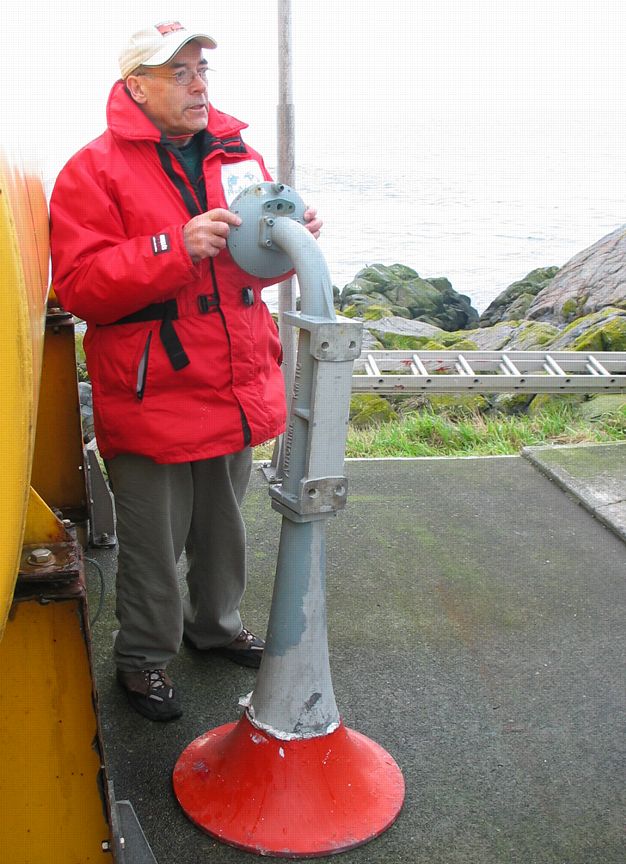 Barry MacDonald, President of the Nova Scotia Lighthouse Preservation Society went out to Race Rocks with Garry today. Barry has been instrumental in getting the Lighthouse Heritage Protection Bill through parliament and working for the protection of the Atlantic Coast Lighthouses: http://www.racerocks.com/racerock/history/heritagetower.htm#Anchor-Pat-11481 . In this picture, he tells us about how the Air Chime Fog horns were once used across North America, but are now all discontinued.The one he is examining was removed for the installation of solar panels and has since been replaced, preserving the look of the four air chimes on the energy building.
Barry MacDonald, President of the Nova Scotia Lighthouse Preservation Society went out to Race Rocks with Garry today. Barry has been instrumental in getting the Lighthouse Heritage Protection Bill through parliament and working for the protection of the Atlantic Coast Lighthouses: http://www.racerocks.com/racerock/history/heritagetower.htm#Anchor-Pat-11481 . In this picture, he tells us about how the Air Chime Fog horns were once used across North America, but are now all discontinued.The one he is examining was removed for the installation of solar panels and has since been replaced, preserving the look of the four air chimes on the energy building.
http://www.racerocks.com/racerock/history/foghorn/foghorn.htm
Boats in The Ecological Reserve 2008
The raw boat data below was taken from the old logs of the Ecoguardian . It has been transferred to this new log. .. GF
‘2008-07-13’, ‘Pleasure’, 3, ‘rowboats’, ‘Garry’, ’07:07:41′),
‘2008-07-21’, ‘Eco-Tour’, 4, ‘Seafaring Safari, twice came in close to docks and rocks to east’, ‘david’, ’16:46:15′),
‘2008-07-23’, ‘Eco-Tour’, 1, ”, ‘Garry’, ’01:45:44′),
‘2008-07-24’, ‘Pleasure’, 1, ‘2 people on board’, ‘Garry’, ’22:10:43′),
‘2008-07-24’, ‘Eco-Tour’, 15, ‘See notes of individuals and numbers in the human contact section’, ‘Garry’, ’22:12:59′),
‘2008-07-25’, ‘Eco-Tour’, 1, ”, ‘Garry’, ’13:51:59′),
‘2008-07-26’, ‘Diving’, 1, ‘One diving boat spotted ca. 15 meters off the dock. Three divers were in the water 10 meters off shore among the kelp.\r\n3 more divers were aboard the boat. Spotting occured ca, 15:30, but it is believed that the boat has been around Race Rocks for several hours.’, ‘Laurie’, ’15:58:51′),
‘2008-07-28’, ‘Eco-Tour’, 1, ‘whale watching boat, “Prince Whales” 10:50 am, hovering in th echannel very close to (ca. 15 meters) basking stellar sea lions’, ‘Laurie’, ’10:58:15′),
‘2008-07-28’, ‘Pleasure’, 13, ‘all vessels were whale watching boats spotted close to sea lions in channel or close to dock between ca. 12 noon and 2 pm\r\n\r\nthe following boats were called:\r\n- Sooke Coastal Expeditions (3 separate occassions!!)\r\n- Whale Watching …Safari\r\n-Five Star Whale Watching\r\n-Eagle Wing Tours.com (twice)\r\n-Great Pacific Adventures\r\n-Prince Whales , Whale Watching (twice)\r\n-Orca…\r\n-Springtide 384-4444\r\n-unnamed red vessel with clients in red water gear ‘, ‘Laurie’, ’15:46:04′),
‘2008-10-20’, ‘Eco-Tour’, 3, ‘Prince of Whales – travelled east between Great Rock and middle rock, passing 30” off the jetty.\r\nPrince of Whales- passed around the front of the island and continued onto the back approaching with 15 feet of the docks. ‘, ‘lbpc’, ’15:55:51′),
‘2008-10-20’, ‘Fishing’, 1, ’30 feet away from back of island, passing slowly.’, ‘lbpc’, ’14:48:13′),
‘2008-10-21’, ‘Pleasure’, 2, ‘1 pleasure boat passed east between Great Race rock and middle rock at high speed.’, ‘lbpc’, ’15:00:10′),
‘2008-10-21’, ‘Eco-Tour’, 9, ‘1 whale-watching boat drifted around north rock at close distance. Another passed within 20 feet of Great Rock on the north side.’, ‘lbpc’, ’16:10:45′),
‘2008-10-21’, ‘Fishing’, 1, ”, ‘lbpc’, ’16:06:51′),
‘2008-10-24’, ‘Eco-Tour’, 3, ”, ‘lbpc’, ’15:37:57′),
‘2008-11-15’, ‘Pleasure’, 0, ”, ‘laurie’, ’08:39:07′),
‘2008-10-21′, ’12:14:27’, ‘Speed’, ‘Boat’, ”, ‘Pleasure boat passed between great rock and middle rock heading east at high speed with lots of wake.’, ‘lbpc’, ’12:15:20′),
July-November 2008 elephant seal notes
July 28 2008 Blasting by the DND sent the 5 newly returned sea lions into water. Slash hits the water to cruise by the dock. 18 Ecotour boats sited in channel close to sea lions (also later main dock where Slash was lying by boat house).
Aug 20. 2008: Three males, slash absent.
Sept. 23, 2008 One juvenile male elephant seal was up on the lawn by the science house.. Slash has not been around for some time now.
Oct. 27, 2008: possibly one male out on middle rock.
http://www.flickr.com/photos/66339356@N00/2965657528/in/set-72157607795979132/
For November of 2008 they have been absent. We expect them back in mid December.
Data Compiled by Garry Fletcher, Nov. 29, 2008
Redeployment of the Tidal Energy Turbine
On October 17, 2008, Clean Current reinstalled the tidal energy turbine at Race Rocks. Timing of the operation had to be around a slack tide, and its always a problem to have enough time for completion of the basic underwater installation work before the tide starts running again. Students and staff of Pearson College will now work in the next few weeks using the 20 minute window of some slack tides to complete several aspects of the installation to prepare the unit for full operation again.
The turbine now has several upgrades developed on the basis of the experience of the first installation. Stainless Steel bearings have now been installed, and a new lubricating system with environmentally friendly lubricant was added. A new electrical wire protection system was added, and the augmenter duct around the outside was replaced with stronger reinforced fibreglass with a reinforced outer ring. The struts holding the central ring were also reinforced, and the blade configuration was modified.
This new deployment will enable a further test of the seaworthiness of the turbine. Perfecting the structure and its operation in these difficult ocean conditions is the goal of the experimental phase of the project.
Erik Schauff of Pearson College took the following pictures of the redeployment and the Pearson College Divers inspecting the apparatus underwater after the professional divers had completed their work.
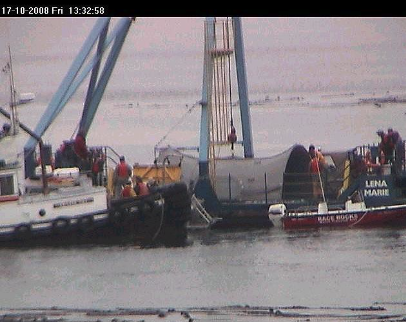 Other pictures of the turbine in various stages of the re-installation can be found captured on the remote control camera 5 on the October Photo Gallery by PB
Other pictures of the turbine in various stages of the re-installation can be found captured on the remote control camera 5 on the October Photo Gallery by PB
Rockfish Conservation Area at Race Rocks
Bentinck Island – Chart 3461
Those waters of Eemdyk Passage in Subarea 20-5 that lie westerly of the meridian passing through 123°32.450’ west longitude and northerly of a line:
| from | 48°18.692’N | 123°33.486’W |
|---|---|---|
| to | 48°18.640’N | 123°32.916’W |
Race Rocks – Chart 3461
Those waters of Subareas 19-3 and 20-5 that lie inside the 40 metre contour line surrounding Great Race Rock and Rosedale Rock as shown on Chart No. 3461, published by the Canadian Hydrographic Service of the Department.
- Date modified by DFO:
- Return to the Regulations for Race Rocks file https://www.racerocks.ca/?p=8909
